
6 minute read
Australian Strawberry Distributors — A Family Affair
Dr Angela Atkinson, Berry Industry Development Officer, VSIDC
The Ripepi family has been growing strawberries in the Yarra Valley for three generations, and now have farms in both Victoria and Queensland. In this article, Jim Ripepi, General Manager of ASD, talks about how it all started, and how the business has evolved over the decades.
Advertisement
Jim’s grandfather, Gaetano Ripepi, came out to Australia from Italy in 1959, and worked for the Board of Works originally, saving up to bring the rest of his family, his wife and children, out in 1961.
For two years the family worked on other farms in the area picking strawberries, amongst other farm work. Eventually, the family bought their first farm, 10 acres in Mt Evelyn, and grew strawberries, beans, carrots and other produce. Jim’s father, Rocco would sell their produce at the Queen Victoria Market, outside growers would later ask Rocco to market their produce for them, starting the family’s involvement as wholesale agents and distributors.
Rocco purchased the farm in Wandin in the 1980’s and Jim and his brothers grew strawberries on that farm. The company’s packing and distribution facility was later built, and is still run from that property today.
The Ripepi’s have been supplying Woolworths since the 1980s when it was known as Safeway. As the supermarkets grew, Safeway demanded better quality fruit and larger quantities, so the family started to grow more of their own fruit to help satisfy demand.
In the early 1990s, Rocco and his brothers Joe and Tony (who has since passed away) formed the company which would become Australian Strawberry Distributors (ASD). They continued to expand, leasing extra land in Silvan, and buying farms at Seville and Catani. They also added a farm and distribution centre in Queensland enabling ASD to supply their customers all year round. More recently, the family has purchased a 300 acre property in Coldstream, which is where all their Victorian strawberries are now grown.
The Coldstream property also has a farm gate shop, Yarra Farm Fresh, stocking fresh Yarra Valley produce and products.
On setting up the Coldstream farm, the Ripepi’s started to plan an expansion into protected cropping and hydroponics. In 2017, a small scale one acre trial was set up, with strawberries grown on tabletops under Haygrove tunnels.
Growing in this way for a couple of seasons enabled the farm managers to understand the differences between growing in the field and growing in substrate under cover, where understanding of irrigation and nutrition control are crucial.
After this trial, it was decided to invest in a Cravo retractable roof greenhouse, to have more control over growing conditions, particularly over the summer months in Coldstream, where temperatures can often be in the high 30s to 40s.

Figure 1. The Cravo greenhouse
Photo credit: Angela Atkinson
The cover chosen for the roof of the greenhouse is not clear, but is a diffuse plastic, which stops transmission of UV light in the hotter months.
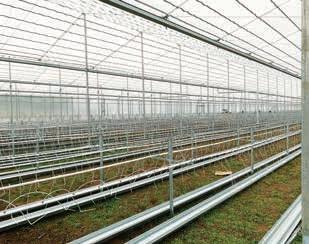
Figure 2. Table tops under construction, showing the diffuse roof material
Photo credit: Jim Ripepi
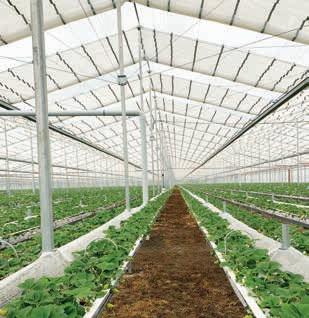
Figure 3. On a hot day the roof is opened 50cm in each bay to allow venting, while blocking UV
Photo credit: Jim Ripepi
The object of the retractable roof is to minimise heat and high UV light in summer, while being able to open the roof in milder weather conditions and let in natural sunlight. On warmer summer days the roof is mostly closed, leaving a gap of about half a metre open in each bay to vent the greenhouse, letting hot air escape.
On a pleasant day, for example in spring, the roof is opened completely allowing natural sunlight in, so they have the advantage of growing in a greenhouse, or naturally, when weather conditions are favourable.
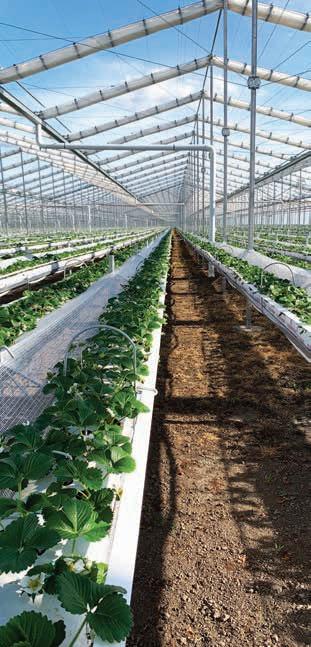
Figure 4. Roof completely open
Photo credit: Jim Ripepi
Opening and closing the roof is computer controlled and can be controlled off site from a phone or tablet. The roof takes two minutes to completely open or close, so the roof can be closed quickly if bad weather is forecast. The walls of the greenhouse can also be raised and lowered automatically when required.
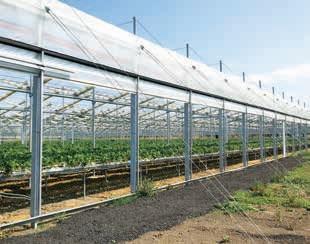
Figure 5. Side walls open
Photo credit: Angela Atkinson
The main advantage of this growing system has been a huge increase in the quality and pack out of 1st grade, quality fruit. In the Cravo greenhouse, the pack out of first grade fruit has increased to 90%, compared with around 70% outside in the field, according to Jim. There are virtually no seconds in the greenhouse grown fruit.
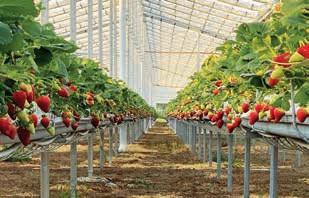
Figure 6. Strawberry crop
Photo credit: Jim Ripepi
In addition to the greenhouse infrastructure, there are innovations in place for controlling all aspects of the growing environment.
Fertigation is controlled by a Priva NutriJet system, which automatically adjusts pH and EC levels in the irrigation lines. The frequency of irrigation throughout the day is determined using a Priva moisture balance system. This differs from the most common form of irrigation control, which usually uses a combination of time and light to control irrigation frequency, where light accumulation, or radiation sum is used to determine when plants are irrigated.
This means that on a bright, sunny day irrigation is more frequent. In contrast, the moisture balance system that ASD is using consists of scales that continually measure the weight of the substrate bags, starting irrigation when the bag weight decreases to a set weight.
What this means is that irrigation is directly in response to the transpiration of the plants, that is, how much water the plants are using up. The system takes into account conditions that can affect the transpiration of the plants other than light, such as increased humidity which reduces transpiration, or increased wind which can increase the transpiration rate.
This gives a more accurate indication of the water needs of the plants than just using light accumulation to control the frequency of irrigation. The fertigation/ irrigation system can also be controlled from a phone or tablet.
Because of the location of the greenhouse on the river flats of the Yarra in Coldstream, run off from the greenhouse had to be contained. All runoff from the tabletops is collected and pumped to storage tanks, where it is then used for irrigation of the field grown strawberries. All rain fall is collected in a dam and used to irrigate the hothouse crops.
As well as setting up innovative production systems, ASD has also been sourcing workers through the Seasonal Worker Program since 2018, as a way of ensuring a stable workforce. They employ 80 workers from Timor each year, and have been happy with the program.
According to Jim, the ability to guarantee access to this workforce each year is important in a business of the size of ASD. Normally these workers would come to Australia for 6-9 months during the season, then return home until the next season.
With COVID-19 this year, the workers have been able to extend their visas and move to other regions for work during our off season. They will return to ASD in October.
The workers also prefer working in the new Cravo greenhouse. It is warmer in winter when they are planting, and in summer it is cooler inside as the roof material blocks the heat and UV rays.
Because the environment inside the greenhouse is cooler in summer, the workers don’t get as tired as they do outside in the heat, where work, health and safety can also be an issue in hot weather. There is also the advantage that work can continue when it is raining.
The greenhouse is around 4ha in size, and while the majority of ASDs production is still in the field, the investment in the greenhouse is proving to be worthwhile for the business moving into the future.



